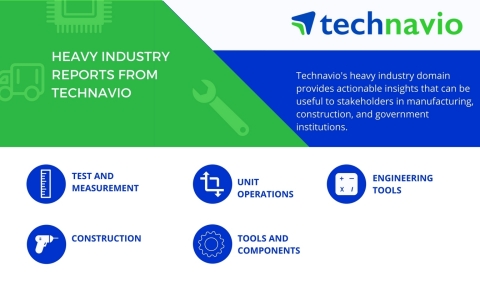Technavio market research analysts forecast the global dry construction market to grow at a CAGR of around 6% during the forecast period, according to their latest report.
This press release features multimedia. View the full release here: http://www.businesswire.com/news/home/20180109006778/en/

Technavio has published a new market research report on the global dry construction market 2017-2021 under their heavy industry library. (Graphic: Business Wire)
The report further segments the global dry construction market by end-user (residential buildings and commercial buildings) and by geography (the Americas, APAC, and EMEA).
This report is available at a USD 1,000 discount for a limited time only: View market snapshot before purchasing
Buy 1 Technavio report and get the second for 50% off. Buy 2 Technavio reports and get the third for free.
Technavio analysts highlight the following three market drivers that are contributing to the growth of the global dry construction market:
- Rise in global construction and infrastructure development activities
- Rapid deployment and other advantages of dry construction
- Adoption of energy and resource efficient construction methods
Looking for more information on this market? Request a free sample report
Technavio’s sample reports are free of charge and contain multiple sections of the report including the market size and forecast, drivers, challenges, trends, and more.
Rise in global construction and infrastructure development activities
The rise in global building construction and infrastructure activities is the most significant factor that will drive demand in the global dry construction market. The number of new constructions in several developed and emerging countries is on the rise after prolonged depression in the construction market. The residential housing completions in the US grew by 8.2% during July 2016 to 2017. The recovery in the US economy has created optimism among home buyers, leading to a demand for new single and multi-family homes.
According to Neelesh Prakash Singh, a lead analyst at Technavio for construction research, “Though the US will account for the biggest single market for dry construction during the forecast period, development activities in APAC and the Middle East will strengthen their position as the fastest growing markets. The fastest growing dry construction markets will include India, China, Malaysia, Saudi Arabia, and the UAE. The growing population in these countries, in combination with rapid urbanization and industrialization, is expected to push the demand for new housing constructions.”
Rapid deployment and other advantages of dry construction
One of the major advantages of dry construction is that buildings or houses can be constructed in an extremely short period when compared with brick and mortar houses. As the components used in dry construction are pre-fabricated in factories, they only need to be assembled at the site of construction. This has led to an escalation in demand for dry construction materials over wet construction.
Dry construction includes the use of materials such as gypsum board, plywood, wallboard, metal supports, and stone wool that only need to be screwed, riveted, or wrenched together and do not require additional time such as mortar to set-in or harden. This significantly cuts down on the installation time and the process is not affected by external environments such as moisture or rainfall.
Adoption of energy and resource efficient construction methods
Increasing concerns about resource depletion, energy saving, and environment are causing people around the world to adopt energy efficient habits, appliances, materials and processes across residential, commercial, and industrial applications. This also applies in the case of construction materials and processes. Several environmental and energy saving benefits that are provided by dry construction is drawing a greater number of builders and home buyers toward its adoption.
“An important advantage of dry construction is that it does not require water during the construction process. While, in wet construction, a large quantity of water is required for mixing cement mortar, cleaning, curing of walls, and other processes. The use of dry construction techniques can result in the saving of precious potable water that can be utilized for human use and agricultural applications,” says Neelesh.
Browse Related Reports:
- Global Concrete Pump Market 2017-2021
- Global Tunneling and Rock Drilling Equipment Market 2017-2021
- Global Flushing Systems Market 2017-2021
About Technavio
Technavio is a leading global technology research and advisory company. Their research and analysis focuses on emerging market trends and provides actionable insights to help businesses identify market opportunities and develop effective strategies to optimize their market positions.
With over 500 specialized analysts, Technavio’s report library consists of more than 10,000 reports and counting, covering 800 technologies, spanning 50 countries. Their client base consists of enterprises of all sizes, including more than 100 Fortune 500 companies. This growing client base relies on Technavio’s comprehensive coverage, extensive research, and actionable market insights to identify opportunities in existing and potential markets and assess their competitive positions within changing market scenarios.
If you are interested in more information, please contact our media team at media@technavio.com.
View source version on businesswire.com: http://www.businesswire.com/news/home/20180109006778/en/

















